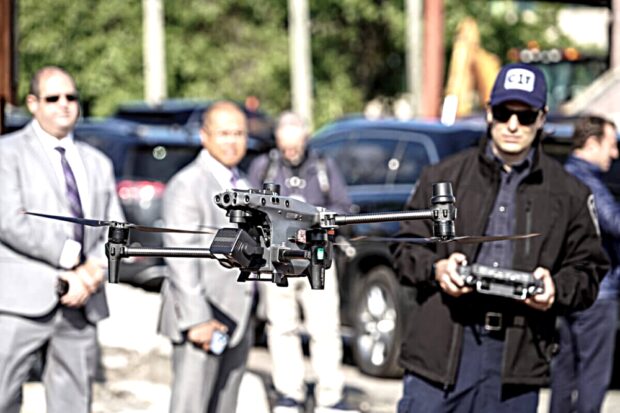The New York City Police Department is testing new drones that are designed to transmit audio messages to the public, such as announcements warning of dangerous weather or nearby emergencies. On Sunday, NYC’s emergency notification system announced on Twitter that the NYPD would be “conducting a test of remote-piloted public messaging capabilities” that day, following several weeks of heavy rain and rare flash flood warnings impacting the city.
A police spokesperson later confirmed to AM New York that these tests took place at Hook Creek Park in Queens, ahead of further downpours expected to hit the city this week, but refused to share the results of its test with the publication. One example of how these audio drones may be utilized is to broadcast messages across neighborhoods at risk of flooding or similar extreme weather events, warning residents to stay inside and seek shelter.
The decision to avoid referring to the remote audio transmitters as drones might be intentional. As Vice notes, the test could be in violation of the Public Oversight of Surveillance Technology (POST) Act — a law that requires the NYPD to seek public comment, publish an impact statement, and use policy 90 days prior to deploying newly acquired surveillance technologies. The same rules don’t apply to all tech in the NYPD’s arsenal, however, with a loophole in the law potentially allowing the agency to deploy new tools immediately by labeling them as “enhancements” to the broad categories under its existing tech policies — such as “Situational Awareness Cameras” and “Unmanned Aircraft Systems (UAS).”
The NYPD is required to include an addendum to old-use policies if the technology will be “reused” for additional purposes. Vice notes that no such addendum has been added to the POST Act’s policy for UAS and that the document currently doesn’t mention emergency announcements as an approved usage for the tech. It isn’t clear if the technology that was tested on Sunday is a new addition to the law enforcement’s toolkit or an update to the NYPD’s existing fleet of police drones.
According to a statement provided to City & State New York earlier this year, this loophole enabled the NYPD to deploy Digidog — its robot police “dog” — without a 90-day delay or creating a new impact and use policy. “The NYPD currently uses situational awareness cameras and GPS technologies, which were the subject of preexisting POST Act impact and use policies,” a spokesperson for the NYPD’s Deputy Commissioner Public Information (DCPI) said to the publication. “The technologies announced today are enhancements to these existing technologies and as such, amendments were made to existing POST Act impact and use policies.”
The NYPD intends to deploy these drones to broadcast critical information in the event of a power or telecom failure, according to a tweet from the official @NYPDnews account. That hasn’t soothed concerns regarding the effectiveness of drones compared to systems like emergency push notifications, however, which can be sent instantaneously to masses of cellphones in an impacted area.
“This plan just isn’t going to fly. The city already has countless ways of reaching New Yorkers, and it would take thousands of drones to reach the whole city,” Albert Fox Cahn, executive director of the Surveillance Technology Oversight Project, said in a statement to Vice. “The drones are a terrible way to alert New Yorkers, but they are a great way to creep us out.”
Other regions have already used drones to police civilians during public emergencies, resulting in some dystopian-sounding videos being published across social media. Drones equipped with speakers in Shanghai, China, and Madrid, Spain, were deployed during the covid-19 pandemic, playing messages warning the city’s residents to comply with strict lockdown restrictions. Shanghai’s drones notably dissuaded the public from singing from their windows, and the city even deployed its very own robo-dog to bark health announcements as it patrolled around the neighborhoods.

